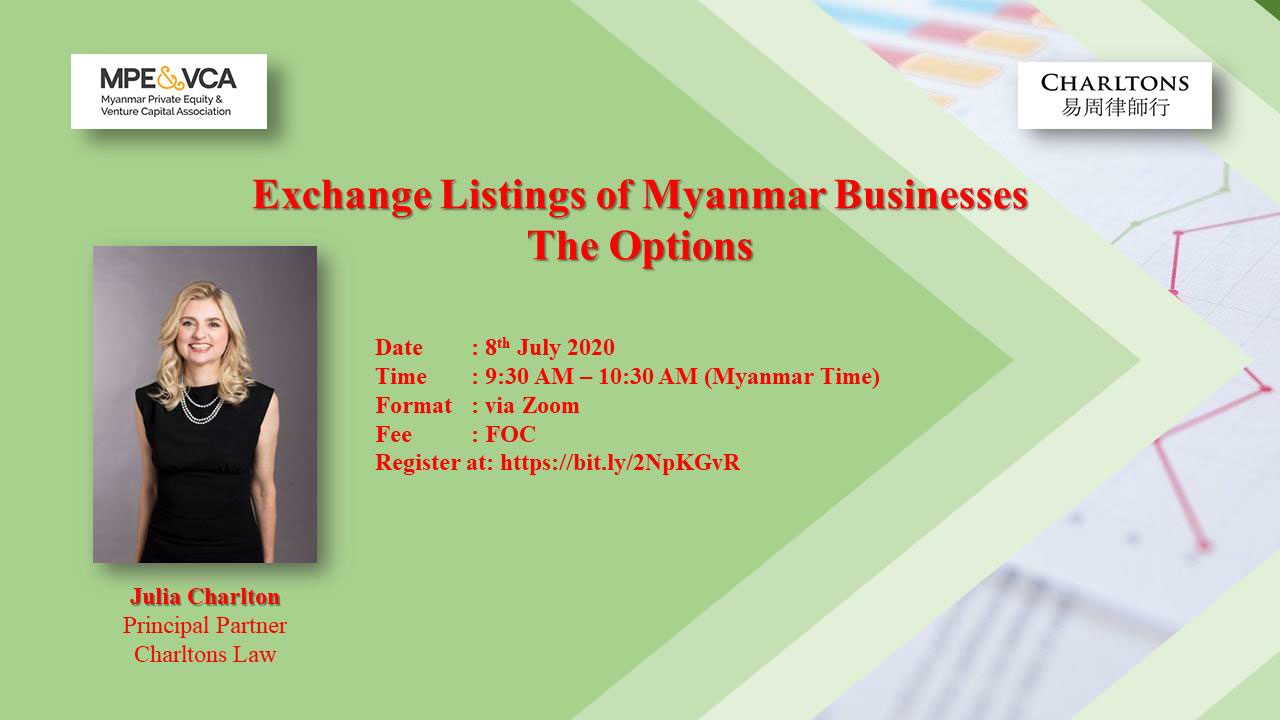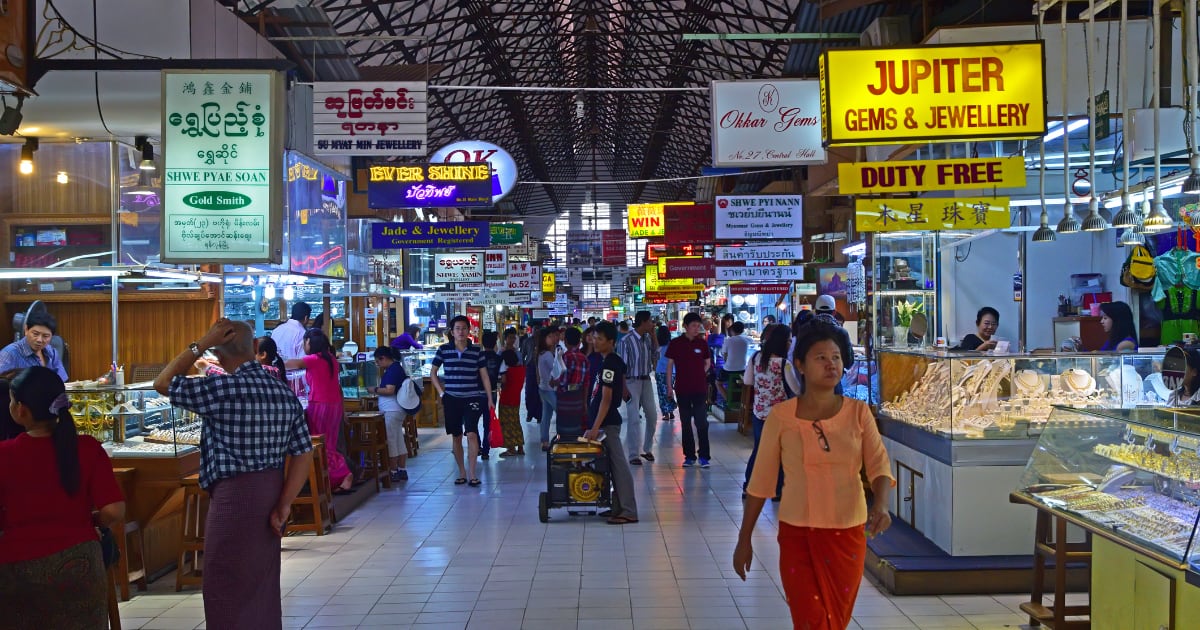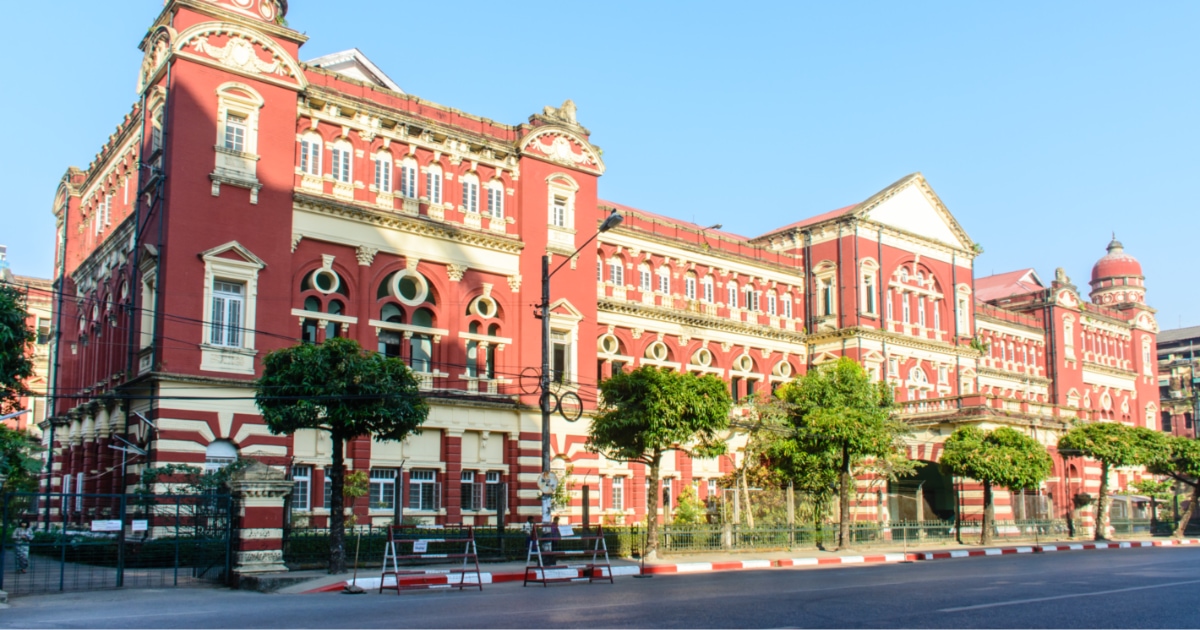
Firstly, Julia looked at the Yangon Stock Exchange (YSX), an early stage stock exchange which has been making strides. , offering limited liquidity and relatively low valuations. In view of these considerations, Julia then looked at possible alternative listing venues for Myanmar companies such as Hong Kong’s Growth Enterprise Market (GEM), Singapore’s Catalist board and London’s Alternative Investment Market (AIM). Julia also covered the dynamic Vietnamese stock exchange and the expanding Thai stock exchange.
| Hong Kong (HKEx) | Singapore (SGX) | London (LSE) | Thailand (SET) | Vietnam (HOSE/HSX) | Myanmar (YSX) | ||||
| Main Board | GEM | Main Board | Catalist | Main Market | AIM | ||||
| Number of IPOs in 2019 | 169 | 15 | 4 | 7 | 36 | 10 | 34 | 27 | 0 |
| IPO Funds Raised in 2019 (USD) | 40.3 bln | 129 mln | 2.2 bln | 50 mln | 4.9 bln | 610 mln | 2.9 bln | 172 m | 0 |
| Number of Listed Companies as at end of Dec 2019 | 2,071 | 378 | 507 | 216 | 1,143 | 863 | 725 | 749 | 4 |
| Market Capitalisation as at end of Dec 2019 (USD) | 4.6 trillion | 13.7 bln | 468 bln | 9.8 bln | 3.9 trillion | 103.1bln | 559 bln | 149 bln | 496 mln |
Hong Kong
Hong Kong is a standout player in Asia, ranking first globally in terms of IPO funds raised in 2019. It offers two markets for listing – the Main Board and GEM, which has lower admission criteria and Hong Kong has become primarily a market for listing Mainland Chinese businesses.
Singapore
Singapore also has two boards, the Main Board and the Catalist and several Myanmar companies have listed in Singapore using Singapore listing vehicles. SGX is a much smaller market for equity listings than Hong Kong and this has been exacerbated by increasing numbers of delistings, due in part to low liquidity and valuations. Singapore however has a stronger market for listed debt, with over 3,000 listed debt securities, representing a total of over US$1 trillion and issuers from 45 countries.
London
London’s Main Market has three segments: Premium, Standard and High Growth, each tailored to different capital raising requirements, with a combined market capitalisation of US$ 3.9 trillion as at the end of 2019.
The AIM is a sub-market of the London Stock Exchange catering for small and high-growth companies and since its launch in 1995, it has become one of the world’s most successful growth markets thanks to its simplified regulatory regime designed for small and emerging companies. There were 830 companies listed on AIM as of June 2020 and daily trading volume for AIM companies averaged £2.4 billion in 2019.
Thailand and Vietnam
Turning now to Thailand and Vietnam. Thailand is Southeast Asia’s second largest economy and has two boards, the SET (the Main Board), on which sizeable companies trade, and the Market for Alternative Investment (MAI), which lists small and medium-sized enterprises. Thailand does have long-term growth potential, but the stock market is predominantly comprised of old economy stocks, lacking technology stocks which benefit from the current work-from-home and at-home entertainment boom.
Vietnam has two major stock exchanges – the Ho Chi Minh City Stock Exchange (HOSE) and the Hanoi Stock Exchange (HSX). A third market, the Unlisted Public Companies Market, has lower disclosure requirements and is aimed at encouraging private companies to publicly trade their shares with a view to going public in the future. There are reports that Vietnam is likely to be upgraded on the MSCI from frontier market to emerging market status, with this expected to attract further foreign capital to the market.
Yangon Stock Exchange (YSX)
To date there are 6 companies listed and market capitalisation of June 2020 was US$490 million.
- FMI (March 2016)
- Myanmar Thilawa SEZ Holdings Public Ltd. (May 2016)
- Myanmar Citizens Bank (August 2016)
- First Private Bank Limited (January 2017)
- TMH Telecom (January 2018)
- Ever Flow River Group Co. Ltd (28 May 2020).
Other companies reportedly considering listing this year are Myanmar Agro Exchange Public Co. Ltd., Myanmar Agribusiness Public Co. Ltd. and Great Hor Kham Public Co. Ltd.
It would seem that the current limited interest in listing on the YSX may include concerns surrounding the impact of enhanced scrutiny and increased transparency, including potential tax liability, concerns over loss of control and the need for greater familiarity with corporate governance requirements for listed companies. Also I would mention liquidity is a problem with companies being relatively reluctant to list in the near term.
Listing Requirements
In order to list on the YSX, a company must be a registered public company limited by shares under the Myanmar Companies Law or under any repealed law. Additionally, a number of track record and financial tests must be met:
- Profitable for 2 years prior to the date of its listing application;
- Paid up capital of > MMK 500 million (approximately US$ 350,000) on the date of its listing application; and
- Having conducted business for a continuous period of at least 2 years prior to listing.
Further, a newly listed company must have a minimum of 100 shareholders at listing and a public float of at least 5,000 shares on the listing date and an expected market capitalisation of the public float at listing of MMK 500 million (US$ 350,000).
Other requirements include:
- Compliance with Myanmar Financial Reporting Standards;
- No restrictions on the transfer of a company’s listed shares (unless imposed by law and / or regulations);
- Shareholder services must be entrusted to YSX as the shareholder services agency;
- Shares must be transferred through the book entry transfer service provided by YSX.
As for the listing process, it typically takes around 18 months involving:
- preliminary preparations (i.e. appointing external advisers, developing a financial and business plan, and perhaps reviewing and restructuring the current ownership structure if necessary);
- further preparations (i.e. finalising historical financials, commencing DD, drafting the prospectus / disclosure document); and
- final preparations (conducting the DD, completing the prospectus / listing document and listing application).
From there, once all listing application documents are submitted to the YSX, it typically takes around 7 weeks (or in practice longer). Upon approval, the YSX will make a website announcement and the prospectus must then be lodged with the Securities and Exchange Commission for approval to offer the shares. The issued shares will then be converted for electronic recording as part of the offering process and listed. Good investor communication and PR is also crucial.
A significant development was Notification No.1/2020, issued by the SECM, permitting foreigners to trade YSX-listed stocks – a move aimed at scaling up the Yangon stock market, increasing liquidity and enabling businesses to access capital to fund expansion. However under the Companies law, a restriction remains on the maximum total foreign stake that may be held in a Myanmar company traded on the YSX (currently set at 35%). Nonetheless, Myanmar’s growth potential is expected to generate foreign investors’ interest in Yangon-listed stocks.
As one of the newest stock exchanges in Asia, the YSX is therefore very much still in its infancy and is in the process of catching up to other regional exchanges. This is not to say however that advantages of investing in YSX-listed stocks do not exist, for example low pricing, and it would seem that the YSX is likely to become an increasingly attractive listing option for Myanmar companies, particularly if the YSX experiences growth like that seen in Vietnamese markets (which saw the aggregate market capitalisation of Vietnam’s top ten listed companies rise 16% year on year to almost US$88 billion in 2019.
Alternative Trading Markets for Myanmar
It is also significant to touch on the proposal (from late 2019) to establish the Myanmar Public Companies Board in order to enable the public, including foreign investors to trade shares of companies not listed on the YSX, with the expectation at that time that the board will be operating by Q4 2020.
The proposal for the Public Companies Board comes in an effort to support the YSX, which sees low daily trading volumes, with the value of traded shares dropping from 1.48 billion Kyats in February 2020 to 1.42 billion Kyats as of March and further to this, as mentioned, many companies are struggling to fulfill the listing criteria.
The creation of an alternative trading market with less restrictive trading rules would therefore provide, in the short-term, an alternative route for Myanmar companies looking to access public capital and in the long term, aid companies looking to eventually list on the YSX, with a timeframe of around five years.
Not to mention the fact that an alternative trading market will foster growth of the Myanmar capital market and allow for greater liquidity. This is in view of the 250 potential candidate companies that could join the Myanmar Companies Board.
The inclusion of foreigners is particularly significant. It was not until 6 March 2020 that the SECM allowed trading by resident and non-resident foreigners, in addition to allowing securities companies to receive applications from foreigners for account openings under the foreign exchange management regulations. Allowing foreigners to trade from day one is therefore an important step highlighting the Myanmar Government’s intention to attract more foreign investment, which will no doubt be beneficial to local businesses.
The success of alternative trading markets in other jurisdictions is an indication of the potential of this proposal. For example the UK-based AIM, the Catalist, the first alternative investment market in South East Asia, and Vietnam’s “Unlisted Public Company Market”, which has around 833 traded firms and a market capitalisation of VND 945.8 trillion (around US$ 45 billion).[1]
Listing Debt (Bonds)
While Myanmar’s bond market is very much in its early strides, with issuance limited to government securities, regulatory developments are expected to pave the way for corporate bond issues and corporate debt securities are included in the Capital Market Development Committee’s plan for the Myanmar market. Meanwhile the SECM is also seeking to create a secondary market for debt securities on the YSX and is currently looking at best regulatory practices for corporate bond issues.
Other Options for Listing
The following considers some of the alternative options for listing, briefly reviewing the listing requirements and the advantages of each venue.
Hong Kong
The Hong Kong Stock Exchange allows full access to foreign investors wishing to trade on its markets, providing listed companies with access to a diverse and global investor base, including Mainland China investors through Stock Connect. The Hong Kong Stock Exchange further offers a listing venue to foreign companies on either of its two boards (Main Board and GEM), which accommodate IPOs of all sizes.
Key advantages of Hong Kong as a listing venue include its established legal system based on English common law as well as its sound and transparent regulatory listing regime, with strong corporate governance standards, which give investors confidence in the Hong Kong stock market.
It offers many tax advantages, currency convertibility, free transferability of securities and no restrictions on capital flow. The abundance of international investment banks, law firms and accountancy firms also facilitate company listings.
Hong Kong also offers foreign companies the chance to raise their profile and visibility in Greater China and the rest of the Asia-Pacific region. In recent years, Hong Kong has seen an increasing number of Mainland Chinese businesses listing in Hong Kong.
There were 2,449 companies listed on the Hong Kong Stock Exchange at the end of December 2019, of which only 218 were incorporated in Hong Kong. Over half of the companies listed are incorporated in the Cayman Islands, which is followed by Bermuda (usually holding Mainland Chinese businesses and assets) and then the PRC. A key factor attracting companies to the Hong Kong market is the depth of liquidity in both its primary and secondary markets.
As for the listing requirements, they are rather onerous and from the perspective of Myanmar companies, there are additional challenges. In order to list on HKEx, a company must be incorporated in one of 4 recognised jurisdictions (Hong Kong, the PRC, Bermuda or the Cayman Islands) OR in one of 27 acceptable jurisdictions OR be deemed acceptable by the Hong Kong regulators.
As Myanmar is currently not deemed to be an acceptable jurisdiction and is currently not likely to be classified as one as Myanmar is not yet a signatory to the IOSCO MMoU and the SECM has not entered into any bilateral agreement with the SFC), a Myanmar company seeking to list on the HKEx would have to restructure under a company incorporated in one of the Recognised Jurisdictions, which would become the listing vehicle. Even then questions may be raised about the suitability of a business based in Myanmar and the HKEx and the SFC would need to be consulted in advance of any application being made.
As for the requirements for listing on the Main Board and GEM, they cover suitability requirements, financial and track record requirements, public float and shareholder spread requirements to name but a few.
A distinctive aspect of Hong Kong’s listing regime is also the requirement to appoint one or more investment banks as sponsors to deal with the HKEx on the listing application. Due Diligence which must be carried out to high levels by the sponsors is a further onerous requirement and ultimately, listing in Hong Kong is relatively expensive and time-consuming.
It is also worth noting that Hong Kong, like many other jurisdictions, has tightened the rules governing reverse takeovers, due to perceptions that they were being used to circumvent the requirements for new listings and the concerns that certain companies were listing on GEM not as a means to raise capital for a genuine business, but as a shell company intending to profit from its status as a listed shell and vehicle for a reverse takeover, mainly due to the demand for shells by mainland companies. In practice, it is also highly unlikely that a Myanmar company seeking to list on the HKEx through a reverse takeover without it being treated as a new listing application, which would mean that the challenges in relation to conventional listing would largely remain.
Hong Kong Bond Market:
As for listing debt in Hong Kong, there are two principal types of debt securities which can be listed on the HKEx (i) debt securities which can be offered to public investors in a retail offering; and (ii) debt securities which can only be offered to professional investors,
The vast majority of debt securities listed on the HKEx are “professionals only” issues, due in part to a simplified regime for professional’s only debt securities. Key advantages of this route for companies are the shorter timeframe for obtaining listing approval and the simplified disclosure requirements. A major current focus of the HKEx currently is to encourage the issuance of green bonds.
Funds:
Listing closed-ended funds on the HKEx is in practice such a difficult process that it is rarely done.
Singapore
The SGX has strong international representation, with around 40% of listed companies’ businesses originating from outside of Singapore. In terms of jurisdiction of incorporation, as at March 2020, there were 465 Singapore companies, 84 China companies and 167 overseas (excluding China) companies listed on the SGX. Of those, a number are Myanmar businesses (with listing vehicles incorporated in Singapore). Some examples include Yoma, Singapore Myanmar Investco, Interra Resources and Memories Group (which listed via a reverse takeover in January 2018). In fact, we have seen Myanmar companies generally list on the SGX via reverse takeover, however there have been instances of rejection. Uncertainties therefore mean that the major shareholders of Singapore-listed companies may be less willing to enter into reverse takeover deals with Myanmar businesses.
The SGX, like Hong Kong, has tightened the requirements for listings by reverse takeovers, with the Listing Rules amended in August 2012 to state that the SGX normally applies the same criteria in assessing reverse takeovers as it does to the assessment of IPOs.
Singapore is ranked as the world’s most competitive economy by the World Economic Forum. A major advantage for growing Myanmar businesses is that to list on Catalist, there is no minimum track record period, market capitalisation or other quantitative listing criteria. Further, expenses associated with listing are generally lower than other global stock exchanges, such as Hong Kong. Issuers must however ensure that their articles of association (or other constituent documents) meet the requirements of the SGX listing rules and for non-Singapore issuers generally, it is also important to note that they are required to announce any change in the law of their home jurisdiction which may affect shareholders’ rights or obligations.
When considering Singapore in the context of the listing of Myanmar companies, it is important to consider that beyond the overall size and liquidity of a particular exchange, arguably the more important consideration is the size, analyst coverage, and liquidity of the relevant sector/ region that the company falls under in that stock exchange. So if a critical mass of Myanmar companies listed on the SGX can be built up based on the current Myanmar listings there, this may create the preferred overseas exchange for Myanmar companies to list going forward.
Singapore Bond Market:
Singapore has a significant bond market and bonds issued by Singapore or Overseas companies, supranationals, governments or governmental bodies or any other entities, whether established in Singapore or elsewhere, can be listed on the Mainboard of the SGX.
AIM
London’s AIM has a key advantage, being that there are no restrictions on where a company is incorporated, with a company eligible to list provided it is properly incorporated under the laws of its place of incorporation and its shares can be offered to the public. A Myanmar incorporated company can therefore list on AIM, but in practice, as with listing in other jurisdictions, the company may wish to restructure for other reasons such as investor preference or tax. Currently there is one Myanmar-based company listed on AIM, Myanmar investments International Limited (a BVI-incorporated company), which raised around US$6 million. The company’s investment portfolio includes AP Towers, one of the country’s largest telecom tower companies and manages a significant proportion of Myanmar’s telecom towers.
AIM is suitable for emerging companies of different sectors that would like to access the UK capital markets for growth which do not meet the listing requirements of the Main Market of the London Stock Exchange. The industry sectors of AIM listed companies are broad and include financial services, tech and mining.
In terms of advantages, listing on the AIM market would not only give companies access to raise further capital for growth, but would also broaden the company’s investor base with London’s institutional investors. The listing will also boost the company’s profile and publicly tradeable shares are more attractive to its staff if the company has a stock option scheme as part of the salary and employee benefits package
As for the listing criteria, AIM’s relatively less onerous and burdensome listing requirements and regulatory compliance could be more attractive to and preferred by emerging companies. Comparing AIM to other growth markets, such as Hong Kong’s GEM, the criteria for listing on AIM are relatively low, with no specific profitability, minimum market capitalisation, revenue or cash flow requirements, albeit directors must be able to show the company has enough working capital to meet its needs for at least the next 12 months.
There is also no mandatory track record requirement, however Nomads typically expect candidates to have a record of sustained growth for at least 3 years, forecasts showing sales continuing to grow and a record that compares favourably with their peers. Directors and senior management must also be able to demonstrate that they have appropriate collective experience and expertise to run all aspects of the business and not have any conflicts of interest.
Further, there are no specific continuous ownership or management requirements, no minimum market capitalisation requirement (save for if the company is an investment company, wherein it must raise at least GBP 6 million in cash via equity fundraising on or immediately prior to admission), no minimum number of shares to be held by the public and no minimum number of shareholders.
In terms of what is required, AIM companies must appoint a nominated advisor (or NOMAD) (an investment bank or accountancy firm which provides advice on the listing application process and complying with the AIM Rules) and retain their services for the duration of their listing. NOMAD’s undertake extensive due diligence to ensure the company is suitable for listing and must confirm that the company is appropriate to be listed and that the directors are capable of managing a listed company.
A further requirement for AIM, unlike most other exchanges, is the requirement for listed companies to maintain a broker at all times (although a NOMAD may also act as the broker).
Of course there are also due diligence requirements in order to identify any risks or issues that may affect the value of shares, the suitability of the company for listing or that require further disclosure to potential investors.
AIM Listing Debt:
It is not possible to list debt instruments on AIM, although they may be listed on the LSE Main Market and the Professional Securities Market.
Listing Closed-end Funds:
Closed- end funds can be listed on the Specialist Fund Segment of the London Stock Exchange and can include funds investing in Myanmar.
Vietnam
Vietnam is a growing and emerging market that is opening up to foreign investors and, as previously mentioned, Vietnam’s stock exchanges have seen tremendous growth, with Vietnam’s VN-Index (which represents stocks traded on the Ho Chi Minh City Stock Exchange) surging 48% in 2017. As of January 2020, stock prices were however low compared to returns. As at June 2020, there are 380 companies listed on the Ho Chi Minh City Stock Exchange and 357 on the Hanoi Stock Exchange, all of which are domestic companies.
Vietnam had a stellar year in 2018, with a market cap of US$3.1 billion and a total of US$ 4.6 billion raised, achieving top performers in Southeast Asia. This was mainly attributable to the privitisation of state-owned enterprises. In 2019, the Government then slowed down equitisation of its SOEs which led to significantly lower funds raised for the year, however in the third quarter of 2019, the Government issued Decision 29 approving a list of 93 SOEs to be equitised by the end of 2020.
As for the listing regime, it is not overly onerous, with low financial eligibility requirements and relatively low listing costs. It is also worth noting that a new Securities Law, which was adopted in November 2019, will come into effect on 1 January 2021, and provides for one stock exchange in Vietnam, the Vietnam Stock Exchange, which may result in the restructuring and merger of the two stock exchanges.
Vietnam Bond Market:
Government bonds are listed on the Hanoi Stock Exchange, whilst corporate issuers may list their bonds on either exchange. However, due to minimum paid-up capital requirements, larger companies generally list their bonds on the HCM City Stock Exchange. The Securities law stipulates the conditions for offering bonds to the public and in addition, conditions for listing are set out in a government decree.
Thailand
Thailand is one of the leading capital markets in the South East Asia Region and the second largest economy in the region and companies listed on the Thai Stock Exchange operate in a range of industries from fashion to transport and logistics. As of June 2020, there were 724 domestic companies listed on the Stock Exchange of Thailand.
Currently, Thai-incorporated and foreign companies can be listed on the Thai Stock Exchange. However, foreign companies are subject to a different listing regime from Thai-incorporated companies. Myanmar companies, along with companies incorporated in Cambodia, Laos and Vietnam, would be subject to a less stringent listing approval regime for foreign incorporated companies. The Thai Stock Exchange is expecting more companies from neighbouring countries to raise funds on the Stock Exchange of Thailand through Real Estate Investment Trusts, with authorities aiming to expand investment alternatives for Thai’s and foreigners alike. Seemingly, the SET has approached owners of hotels, office buildings, shopping malls and other properties in Laos, Cambodia and Myanmar to tap its capital market for long-term funds. It was also noted that Myanmar has the highest potential for new issuers among neighbouring countries owing to its relatively large population, pace of economic growth and developing financial system, coupled with Thai investors looking for investment alternatives.
Key advantages which the Stock Exchange of Thailand claims it has include potentially providing issuers with a more liquid market, with the Stock Exchange of Thailand having the top rank in terms of trading liquidity in ASEAN and visibility.
The key listing requirements for listing on the Stock Exchange of Thailand and Market for Alternative Investment are briefly summarised, with as you can see, requirements for listing on the MAI being much more flexible than those of Thai Stock Exchange with key differences including lower paid-up capital, fewer consecutive years prior to qualifying for listing required, fewer minor shareholders required and lower fees. The Stock Exchange of Thailand does however state that they apply the same criteria and regulations governing distribution of shares to them, as to any other listed firms and MAI-listed companies must meet the same criteria as those listed on SET concerning public disclosure of information. Therefore, in the words of the SET, “MAI-listed and SET-listed companies are of the same quality.”
Thailand Bond Market:
Debt instruments can be listed on the Bond Electronic Exchange (BEX) launched by the SET in 2003. 273 bond issues are currently listed with a total size of approximately USD 227 million. Approval must be received from the Securities and Exchange Commission (SEC) for bonds to be listed on the BEX and both listed and non-listed companies can apply to list their debt instruments.
India and Pakistan
India
Currently, foreign companies are not allowed to directly list their equity shares on the Indian stock exchanges. Hence, these companies set up subsidiaries in India and get listed. There are around 150+ Indian subsidiaries of foreign companies listed on the Bombay Stock Exchange with a combined market capitalisation of 10% of the total market capitalisation of all companies listed on the Bombay Stock Exchange. Examples of multinational corporations in India in which the foreign shareholding is over 50% and/or the management control is vested in the foreign company include Colgate-Palmolive (India); United Spirits (which is listed on both the National Stock Exchange and the Bombay Stock Exchange); and Nestle India.
Following a report published in December 2018 by a committee constituted by the Securities and Exchange Board of India, advocating for the overseas listing of Indian companies which laid a blueprint for the legal changes necessary, the Companies (Amendment) Bill 2020 was introduced on 17 March 2020, which, among a series of amendments to the Companies Act 2013, includes provisions allowing Indian companies to list securities directly on overseas stock exchanges. Allowing listing on overseas stock exchanges marks a departure from the existing regime, since Indian companies can currently only access foreign equity capital markets by issuing depositary receipts. Permitting Indian companies to list in this manner on overseas stock exchanges gives them access to a choice of jurisdictions from which capital may be raised, with varying costs of capital and listing conditions, and offers the benefit of increased visibility and grants access to investor bases with a greater understanding of, and appetite for, niche businesses. The Bill also creates the opportunity for Indian companies to list their shares on stock exchanges of various jurisdictions at the same time, allowing them to distribute home market risks. While there are different models through which companies achieve such multiple listings internationally, the Indian Government appears to be considering “cross listing” where the same company lists its shares on multiple stock exchanges.
Pakistan
The Pakistan Stock Exchange came into existence in January 2016, following the merging of the three exchange markets (the Karachi, Islamabad and Lahore). In terms of performance, the PSX was not in an ideal state in 2019, with Bloomberg claiming it was the “world’s worst” having erased “half of their market value”. There was however slight growth over the past fiscal year and the benchmark KSE-100 share index was marginally up by around 2% in the 2019 financial year and the KSE-100 index increased by 18% during Q4 of the 2019 financial year.
Foreign companies are allowed to list on the PSX and in terms of investors, there are approximately 1,886 institutional investors and 883 domestic institutional investors along with around 220,000 retail investors.
Concluding Remarks
Other listing venues such as the Philippine Stock Exchange, the Kuala Lumpur Stock Exchange (Bursa Malaysia) and the Australian Securities Exchange (ASX) are examples of further exchanges which could be considered. Listing the depositary receipts of Myanmar companies already listed on an exchange is also a future potential option. For Myanmar funds there are also exchanges such as Luxembourg and Ireland.
We should also reflect on the fact that the future of exchanges may be digital and just as Myanmar’s Fintech sector is surging ahead, it’s possible to envision a scenario in which an online digital exchange with trading through a mobile app could quickly emerge for trading in fiat currency and settlements through one of Myanmar’s thriving online payment systems. This would allow Myanmar to leapfrog the stage of growing a more physically based exchange based on existing models drawn from the pre-tech world.
[1] https://vietnamnews.vn/economy/521762/unlisted-public-company-market-promises-investors-better-performance.html
This newsletter is for information purposes only. Its contents do not constitute legal advice and it should not be regarded as a substitute for detailed advice in individual cases.
Transmission of this information is not intended to create and receipt does not constitute a lawyer-client relationship between Charltons and the user or browser.
Charltons is not responsible for any third party content which can be accessed through the website.
If you do not wish to receive this newsletter please let us know by emailing us at unsubscribe@charltonslaw.com







